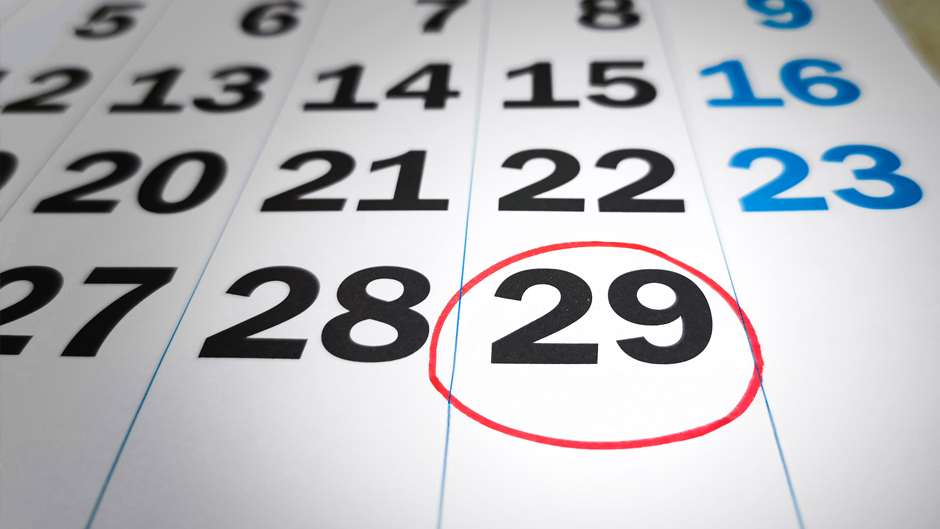Leap years, the occasional phenomena when we add an extra day to our calendars, have always piqued human curiosity. Though it can be fun to joke with those born on the 29th of February that they are a quarter of their age, it isn’t clear to most people how leap years originated, nor what significance they hold in our understanding of time.
According to NASA, a leap year adds an extra day to the typical 365-day calendar in order to stay synchronized with a full seasonal year. It has been estimated that Earth’s rotation is roughly 365.25 days around the sun in a full rotation, so the extra day is added every four years to make up for this deficit.
“We need that one extra day to kind of bring us back into sync,” said Charles Bartlett, a visiting assistant professor in the University of Miami College of Arts and Sciences who earned his Ph.D. from Harvard University with a specialization in ancient history. “We wouldn't probably notice it after a couple of years but expand that out to 40 years or a couple of decades, then you would start to eventually see seasonal changes.”
The concept of leap years finds its roots dating all the way back to the ancient Roman Empire. Early attempts were made to reconcile the discrepancies between the human-made calendar and the natural cycles of Earth, which Romans knew did not equate to exactly 365 days per year.
Instead of adding a day to their calendar every four years, they added an entire extra month, though the months in the Roman early calendars were often shorter than the 30 and 31 day months of the calendar the world follows today.
“In some ways, what's most interesting about this is that it’s also reflected in what's called the Julian calendar, which is based on Julius Caesar,” said Bartlett.
“We talk about aligning our temporal practices with the natural world, but what calendars we use to do that are a hugely important political statement,” he added. “If you can make an argument about who should design a system to control time, or to specify the time according to which people live their lives, that's a really important statement to the world.”
The transition from the Julian calendar to the Gregorian calendar in 1582 marked another significant milestone in the evolution of leap years. Bartlett contextualizes this shift within the broader framework of European colonization, noting how the standardization of temporal systems was used to serve more imperialistic agendas.
Ancient societies across the globe have also grappled with the challenge of harmonizing their calendars with the Earth’s natural rhythms. Beyond Rome, civilizations such as the Mayans and the Egyptians devised their own methods for tracking time, often tied closely to celestial events and agricultural cycles.
“In practical circumstances, [the Gregorian calendar] is not as huge of a shift as in the case of the original Roman calendar, or the Julian calendar,” Bartlett said.
“It's not the absolute ‘heyday’ of European imperialism yet, which is to say that more of the Earth's territory will be ruled by Europe in centuries to come. But the more you bring people into contact with one another and give them a common language, a metrical language, the more likely you are to deepen those connections through things like how you all perceive time,” he shared.
Leap years have not been immune to this influence of political power and social upheaval over time. The French Revolution, for instance, witnessed a radical attempt to overhaul the calendar, with new months and new reckoning systems introduced in an effort to break with the past. Even during the Benito Mussolini regime of 1930s Italy, the fascist leader created his own calendar system as a means to base time on more atheistic principles and set a new precedent for citizens to follow.
“It's one thing to reckon time in a cyclical fashion, where you're trying to accord with this natural year, but it's another thing to count years as well,” Bartlett added. “For instance, we start counting years before and after the birth of Jesus Christ, whereas the Jewish calendar has a totally different dating scheme and in various Chinese calendars it’s a different year entirely.”
As for when today’s world began to adopt the same universal calendar with the added date to February, Bartlett has several theories, from the Eurocentric origins of the imperialist calendar to the rise of industrialization and the start of the “workday.”
“I think there are more people who are at least hyperaware of using leap years or other methods to bring a calendar year in accordance with a natural year,” Bartlett said. “I believe it's really a product of industrialization more than anything else in the sense that you have to structure a workday from nine to five—which is a relatively recent mass phenomenon in human history—while also maintaining this kind of widespread observance and insistence upon that absolute precision of what time it is.”
In essence, leap years serve as a constant reminder of our enduring fascination with the passage of time.
"Leap years force us to think about the fundamental basis of time reckoning, and it’s a nice reminder that we can try to calculate nature and quantify it,” Bartlett concluded. “We all have Apple watches and all these things to kind of specify nature, but we’re also dependent upon it in an interesting way. And that’s its purpose—to maintain some consistency in terms of when, within seasons, things happen."

